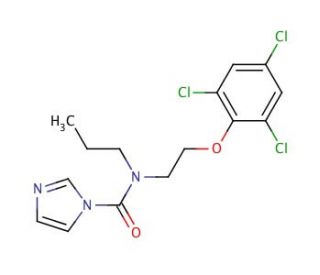

Prochloraz (CAS 67747-09-5)
See product citations (2)
QUICK LINKS
Prochloraz, an imidazole antifungal, exerts its effect by inhibiting the synthesis of ergosterol. This inhibition occurs through the cytochrome P450-dependent 14α-demethylation of lanosterol, leading to the disruption of the fungal cell membrane and subsequent cell death. Chemically, prochloraz is classified as a urea compound, specifically 1H-imidazole-1-carboxamide substituted by a propyl group and a 2-(2,4,6-trichlorophenoxy)ethyl group at the amino nitrogen atom. It functions as an antifungal agrochemical, an inhibitor of EC 1.14.13.70 (sterol 14α-demethylase), and is characterized as an aromatic ether and trichlorobenzene. Furthermore, it falls into the categories of ureas, imidazoles, amide fungicides, conazole fungicides, and imidazole fungicides. Classified as a phenol ether, prochloraz is an aromatic compound in which an ether group is substituted with a benzene ring. While it possesses potent antifungal properties, it should be noted that prochloraz is a potentially toxic compound with environmental contaminant properties.
Prochloraz (CAS 67747-09-5) References
- Prochloraz: an imidazole fungicide with multiple mechanisms of action. | Vinggaard, AM., et al. 2006. Int J Androl. 29: 186-92. PMID: 16466539
- Prochloraz-induced oocyte maturation in rainbow trout (Oncorhynchus mykiss), a molecular and functional analysis. | Rime, H., et al. 2010. Toxicol Sci. 118: 61-70. PMID: 20805220
- Effects of prochloraz on DNA damage, lipid peroxidation and antioxidant system in vitro. | Alpertunga, B., et al. 2014. Toxicol Mech Methods. 24: 268-75. PMID: 24401010
- Prochloraz causes irreversible masculinization of zebrafish (Danio rerio). | Baumann, L., et al. 2015. Environ Sci Pollut Res Int. 22: 16417-22. PMID: 25163568
- Fungicide prochloraz induces oxidative stress and DNA damage in vitro. | Lundqvist, J., et al. 2016. Food Chem Toxicol. 91: 36-41. PMID: 26945613
- Size-Dependent Effect of Prochloraz-Loaded mPEG-PLGA Micro- and Nanoparticles. | Zhang, J., et al. 2016. J Nanosci Nanotechnol. 16: 6231-7. PMID: 27427695
- Fungicidal Actions and Resistance Mechanisms of Prochloraz to Penicillium digitatum. | Zhang, Y., et al. 2021. Plant Dis. 105: 408-415. PMID: 32729798
- Characterization of Prochloraz Resistance in Fusarium fujikuroi from Heilongjiang Province in China. | Peng, Q., et al. 2022. Plant Dis. 106: 418-424. PMID: 34353125
- Fabrication and Characterization of Prochloraz Nanoemulsion against Penicillium citrinum for the Postharvest Storage of Navel Oranges. | Chen, Z., et al. 2021. Langmuir. 37: 13757-13766. PMID: 34748347
- Prochloraz alone or in combination with nano-CuO promotes the conjugative transfer of antibiotic resistance genes between Escherichia coli in pure water. | Guo, A., et al. 2022. J Hazard Mater. 424: 127761. PMID: 34799177
- Ozone: a promising alternative to prochloraz for cold storage of pomegranate. | Buluc, O. and Koyuncu, MA. 2022. J Food Sci Technol. 59: 2731-2740. PMID: 35734134
- The prochloraz chronic exposure to Daphnia magna derived in biochemical alterations of F0 generation daphnids and malformed F1 progeny. | Salesa, B., et al. 2022. Chemosphere. 307: 135848. PMID: 35948089
- Dissipation and Distribution of Prochloraz in Bananas and a Risk Assessment of Its Dietary Intake. | Huang, J., et al. 2022. Toxics. 10: PMID: 36006113
- Construction of Prochloraz-Loaded Hollow Mesoporous Silica Nanoparticles Coated with Metal-Phenolic Networks for Precise Release and Improved Biosafety of Pesticides. | Shi, L., et al. 2022. Nanomaterials (Basel). 12: PMID: 36014750
- Monitoring and characterization of prochloraz resistance in Fusarium fujikuroi in China. | Gao, X., et al. 2022. Pestic Biochem Physiol. 187: 105189. PMID: 36127064
Ordering Information
| Product Name | Catalog # | UNIT | Price | Qty | FAVORITES | |
Prochloraz, 250 mg | sc-236463 | 250 mg | $51.00 |
